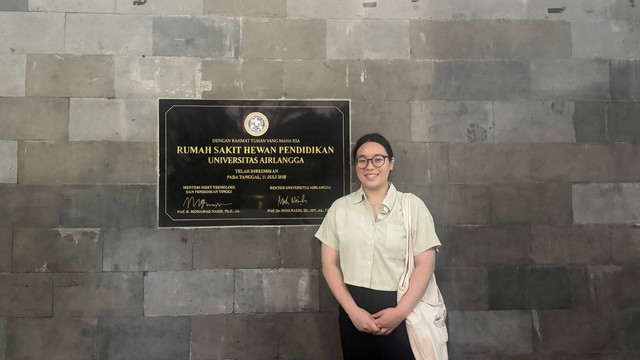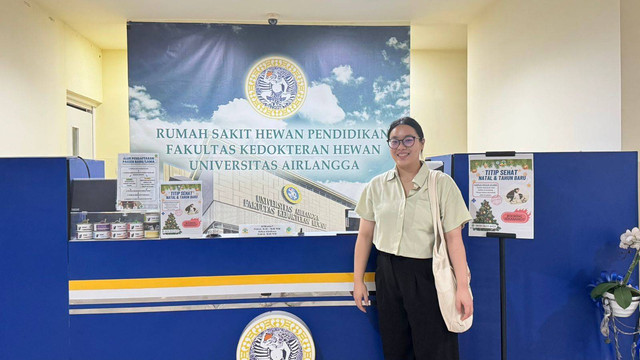Tentang KamiPedoman Media SiberKetentuan & Kebijakan PrivasiPanduan KomunitasPeringkat PenulisCara Menulis di kumparanInformasi Kerja SamaBantuanIklanKarir
2025 © PT Dynamo Media Network
Version 1.102.2
Konten dari Pengguna
Effective Communication in Veterinary Health Services
29 Desember 2024 14:08 WIB
·
waktu baca 3 menitTulisan dari Joyce Chew tidak mewakili pandangan dari redaksi kumparan

ADVERTISEMENT
Observational studies conducted on Friday, November 15, 2024, at "Rumah Sakit Hewan Universitas Airlangga" showed the complicated nature of communication within veterinary practices. As a veterinary student deeply invested in animal health and welfare, I had the opportunity to visit Rumah Sakit Hewan at Universitas Airlangga. This visit allowed me to observe and appreciate the dynamics of communication in a clinical veterinary setting. It highlighted the crucial role of effective interpersonal skills in fostering trust, cooperation, and clarity in veterinary practice.

The Reception: First Impressions Matter
ADVERTISEMENT
Upon entering Rumah Sakit Hewan, I was immediately struck by the professionalism and calmness of the environment. The reception area served as the primary interaction point between hospital staff and pet owners. Here, friendly greetings from the front desk staff visibly eased the anxiety of many pet owners. Their clear and polite discourse, accompanied by warm smiles and steady eye contact, helped establish an atmosphere of trust and comfort.
Communication with Pet Owners
One of the most impactful observations was the way veterinarians interacted with pet owners. Verbal explanations were clear and concise, often supported by hand gestures or visual aids to enhance understanding. For instance, during a discussion about a surgical procedure, a veterinarian used diagrams of canine anatomy to clarify the process for a concerned dog owner. This combination of verbal and visual communication made complex medical information accessible to non-experts.
ADVERTISEMENT
Empathy was a recurring theme in these interactions. I witnessed a veterinarian discussing a kidney disease diagnosis with a distressed cat owner. The veterinarian spoke softly, maintained eye contact, and used empathetic language, saying, "I understand how difficult this must be." Such an approach reassured the client and fostered a sense of trust. Additionally, open-ended questions like, "How has your pet been behaving recently?" encouraged clients to share valuable insights about their pets’ health, ensuring comprehensive care.
Nonverbal communication also played a critical role. Steady eye contact, gentle nods, and a composed posture demonstrated active listening, while subtle gestures like leaning forward or resting hands on the desk conveyed attentiveness and empathy.
ADVERTISEMENT
Interprofessional Communication
Effective communication extended beyond client interactions to the teamwork between veterinarians and veterinary nurses. I observed collaborative discussions where direct language was used to ensure clarity. Statements like, "Let’s review the X-ray results together," and "Please prepare the sedation medication," showcased the emphasis on teamwork. Nonverbal cues such as nods and affirming gestures further supported mutual understanding and alignment among team members.
Lessons and Insights
My visit to Rumah Sakit Hewan highlighted the indispensable role of communication in veterinary practice. Clear verbal instructions, supported by nonverbal cues, ensured smooth workflows and mutual understanding. However, flexibility in communication emerged as a critical skill, especially in addressing language barriers and managing high-stress scenarios.
ADVERTISEMENT
Conclusion
This experience reinforced my understanding that strong communication skills are just as essential as clinical knowledge in veterinary practice. Effective communication fosters trust, enhances collaboration, and ensures clarity in patient care. Challenges such as language barriers test these skills but also offer valuable learning opportunities. My visit to Rumah Sakit Hewan has broadened my perspective on compassionate and effective healthcare, underscoring the importance of honing communication skills for aspiring veterinarians.

